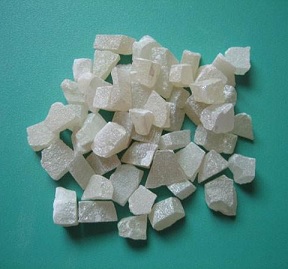| Occurrence and Uses | Zinc sulfide occurs in nature in two crystalline forms, the minerals, wurtzite, and sphalerite. Sulfide ore is the principal zinc mineral.

The most important use of Zinc sulfide is as a pigment. As lithopone, a mixture with barium sulfate, it forms a low gloss interior house paint. The pigment, “mineral white” is made by combining zinc sulfide with zinc oxide. Zinc sulfide is incorporated into phosphors to produce luminescence when irradiated with light. It is used in making luminous dials, x-ray and television screens, and fluorescent lights. Also, it is used in making white and opaque glass and as a base for color lakes (which consist of an organic pigment with an inorganic carrier). |
| Physical Properties | Zinc sulfide is white to gray-white or pale yellow powder. It exists in two crystalline forms, an alpha (wurtzite) and a beta (sphalerite). The wurtzite form has hexagonal crystal structure; refractive index 2.356; density 3.98 g/cm3; melts at 1,700°C; practically insoluble in water, about 6.9 mg/L; insoluble in alkalis; soluble in mineral acids. The sphalerite form arranges in cubic crystalline state; refractive index 2.368; density 4.102 g/cm3; changes to alpha form at 1,020°C; practically insoluble in water, 6.5 mg/L; soluble in mineral acids, insoluble in alkalis. When zinc sulfide contains water, it slowly oxidizes to sulfate on exposure to air. |
| Uses | Zinc sulfide is well known as an optical coating material for its high refractive index (~2.35 at 500 nm) and very broad transmittance range from 400 nm up to 14 µm. It allows for coatings in the IR and VIS range with good environmental durability, and can be evaporated rapidly from e-beam and resistance heated sources. It is used as a semiconductor and in photo optic applications.
Copperactivated zinc sulfides are the most widely used phosphors for safety purposes.
Zinc sulfide and white lead are sometimes used in coating materials because of their fungicidal properties and to neutralize acid to protect against corrosion. |
| Production | Zinc sulfide is mined from natural deposits and concentrated by various processes.
Also, zinc sulfide may be prepared in the laboratory by passing hydrogen sulfide through an aqueous solution of a soluble zinc salt, such as zinc chloride or zinc nitrate. The precipitate is filtered, washed, and dried. |
| Chemical Properties | Yellowish-white powder. ZnS exists in two crystalline forms, α (wurtzite) and β (sphalerite). Stable if kept dry. α: d 3.98. β: d 4.102, changes to α form at 1020C. Sublimes at 1180C. Soluble in acids; insoluble in water. |
| Uses | Pigment for paints, oilcloths, linoleum, leather, dental rubber, etc., especially in the form of lithopone; mixed with ZnO as "mineral white." Anhydrous zinc sulfide is used in x-ray screens and with a trace of a radium or mesothorium salt in luminous dials of watches; also television screens. |
| Uses | Zinc sulfide (ZnS) is used as a pigment and to make white glass, rubber, and plastics. It is an ingredient in pesticides, luminous paints, and X-ray and television screens. |
| Uses | Zinc Sulfide is used as a friction material to carry sulfur, which hardens rotor surfaces and thereby reduces wear. Also in printing inks, UV-hardened systems, powder coatings, adhesives, insulating & sealing compounds, thermoplastic pigmentation, thermosets, flame resistant plastics, glass-fiber reinforced plastics, pigment concentrates, elastomers,. textile fibers, paper, mastics, lubricants, electroluminescent lamps, infrared windows, domes and optical elements. |